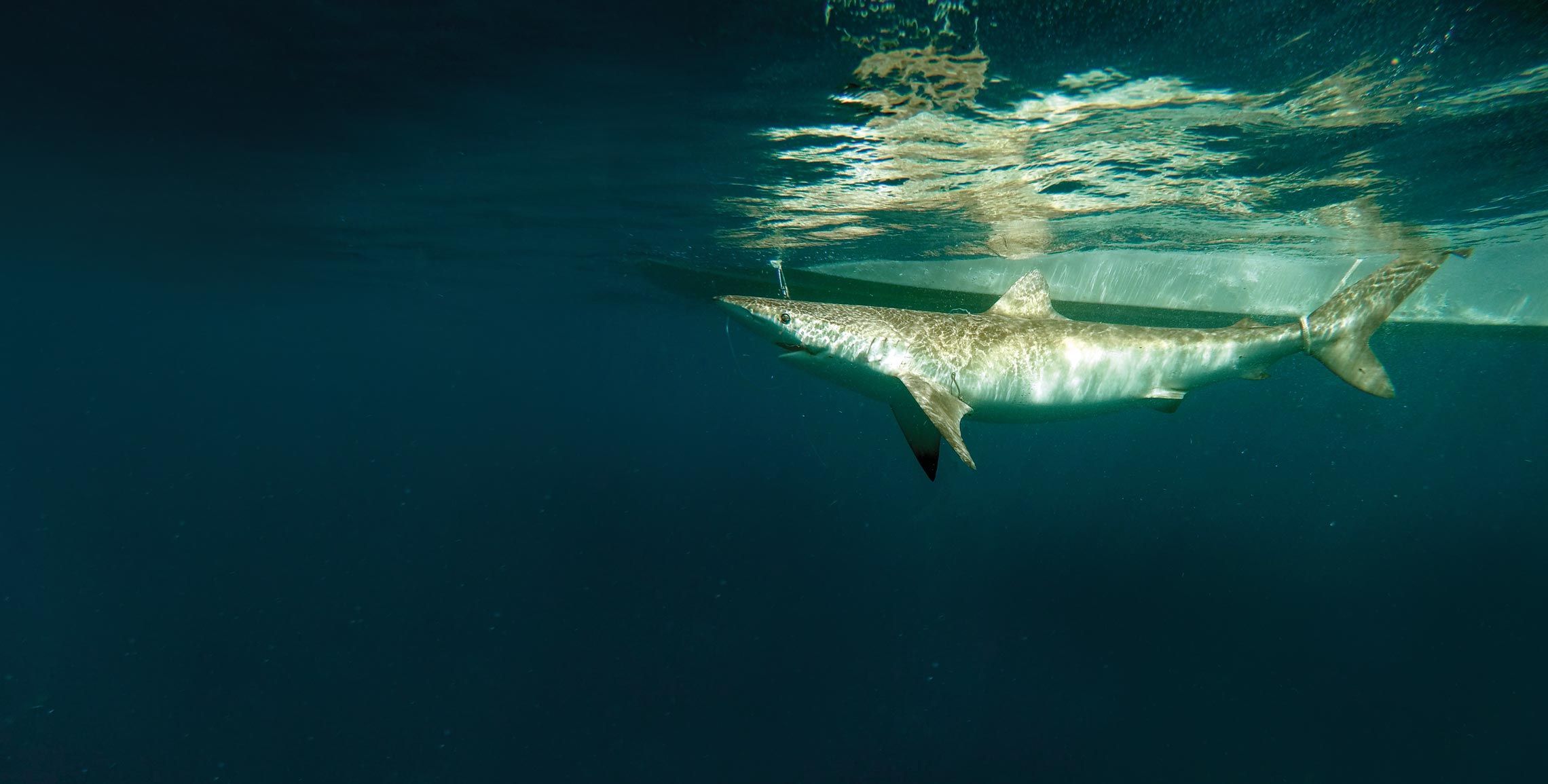Sharks are survival specialists. They emerged roughly 450 million years ago and have lived through five major mass extinction events. The most recent, which occurred about 66 million years ago, caused the extinction of the dinosaurs, which themselves only appeared on earth some 200 million years after sharks. Now, a number of shark species are facing a threat to their evolutionary future: in addition to decreasing populations, overexploitation seems to be affecting their genetic diversity and harming their adaptive potential as a result. Overfishing can reduce their ability to adapt to environmental changes, raising questions over their chances of survival in the twenty-first century. These are the main conclusions of an article published in the scientific journal Aquatic Conservation: Marine and Freshwater Ecosystems, in September.
The paper presents the results of a genetic study of the night shark (Carcharhinus signatus). The lead author, biologist Rodrigo Rodrigues Domingues, completed his PhD on the subject in 2016 at the State University of São Paulo (UNESP), under the supervision of Otto Gadig. The night shark lives in the Atlantic Ocean, from Florida in the southern USA to Argentina, at depths of less than 100 meters. Domingues found that the South Atlantic night shark population has the lowest genetic diversity of any shark species from the Carcharhinus genus studied so far. The analyses used mitochondrial molecular markers, passed down exclusively via the maternal bloodline, and nuclear DNA, inherited from both the father and the mother. “In addition to the night shark study, we published a review last year of all the genetic diversity indices for sharks and rays from 1983 to August 2016. The article proved that genetic diversity in sharks is low,” says Domingues, who is currently studying a postdoctorate at the Federal University of São Paulo (UNIFESP), Santos campus.
He has previously studied another species from the same genus—the silky shark (Carcharhinus falciformis), which is found worldwide—and did not find any indication of low genetic diversity in relation to other sharks. However, with the current pressure faced by the species due to overexploitation, the researcher has not ruled out that such a situation could soon be observed. Classified as vulnerable on the International Union for Conservation of Nature (IUCN) Red List, both species have a high commercial value, mainly due to the high prices paid for their fins on the Asian market. According to an article published in the scientific journal Fisheries Research by researchers from Dalhousie University, Canada, in 2010, overfishing has led to population declines of over 75% among these two species.
In addition to analyzing DNA samples of fish from the Brazilian and South American coasts, Domingues had access to genetic material from the Northern Hemisphere thanks to a collaboration with geneticist Mahmood Shivji, from Nova Southeastern University, USA. Comparing data from populations above and below the equator indicated that the species is less genetically diverse in the South Atlantic than in the North. “The difference does not necessarily mean that the South Atlantic shark population is being affected by fishing. It could also be explained by historical and evolutionary factors,” says biologist Ricardo de Souza Rosa, from the Federal University of Paraíba (UFPB), who did not participate in the night shark and silky shark studies. “The lower diversity, however, suggests a need to better manage the species, which could arrive at a genetic bottleneck if fishing reaches critical levels.”
Genetic drift
Overfishing does not only affect population size, it also decreases genetic variation among the individuals of a species. By reducing the size of a population, fishing increases the chances that part of its genetic variability will be lost, explains Domingues, and intensifies a process known as genetic drift. By the mechanism of natural selection, the genes passed onto the next generation are those that help the species best adapt to its environment. When genetic drift occurs, the alleles (alternative forms of the same gene) passed down are completely random and no longer favor traits advantageous to the survival of the species. Over many generations, this can result in the elimination of certain alleles, even ones that are beneficial. The species thus becomes more genetically homogeneous and therefore more vulnerable to environmental changes.
Alexandre Wagner Silva Hilsdorf, a geneticist from the University of Mogi das Cruzes (UMC) and coauthor of the night shark and silky shark studies, explains that genetic drift can occur in all species, but the smaller the affected population, the faster and more intense its effects tend to become. Among sharks, the process poses an even greater risk because these cartilaginous fish naturally have less genetic variability than other groups, such as bony fish and marine mammals. There are various hypotheses that seek to explain why. Some theories suggest a link to the five mass extinction events that the sharks—whose 1,160 species represent just 3% of modern-day fish fauna—have survived over the course of their evolutionary history. “Because sharks are migratory species that inhabit international waters, countries need to work together to encourage their conservation and sustainability, especially of those that are fished,” says Hilsdorf.
Project
Genetic connectivity, phylogeography, and conservation of pelagic sharks in the Western Atlantic Ocean (nº 13/08675-7); Grant Mechanism PhD Grant; Principal Investigator Otto Bismarck Fazzano Gadig (UNESP); Scholarship Beneficiary Rodrigo Rodrigues Domingues; Investment R$155,684.55.
Scientific article
DOMINGUES, R. R. et al. Genetic connectivity and phylogeography of the night shark (Carcharhinus signatus) in the western Atlantic Ocean: Implications for conservation management. Aquatic Conservation: Marine and Freshwater Ecosystems. Sep. 11, 2018.
